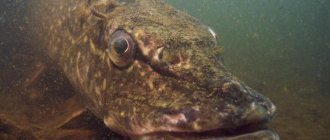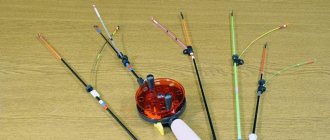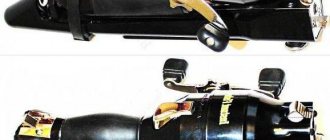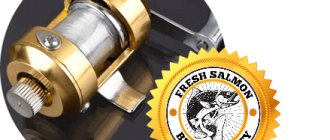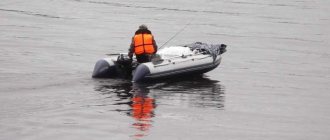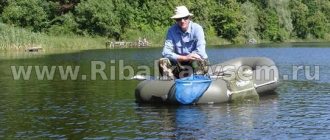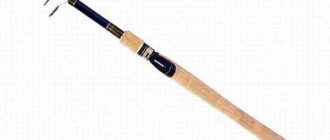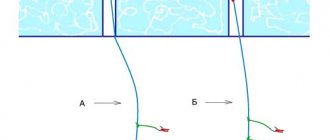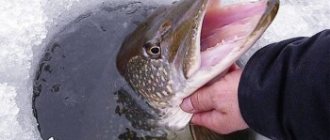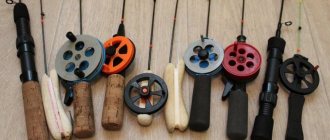Alexey Falaleev | July 5, 2021
In the material presented to the readers of the magazine, I will talk about such an interesting method of fishing as catching predatory fish with a float. Fishing with a float rod with live bait is one of the most emotional and energetic fishing experiences. And if you approach it wisely, then in addition to positive emotions you will also get quite decent catches.
I think I won’t be wrong if I assume that most fishermen started their journey with a float rod. Our first fishing trips happen in childhood, when, not really knowing how to do anything and understanding little about fishing, we find ourselves on a pond. And what a joy - well, remember! — when you notice a float running under the water, you sharply pull the fishing rod towards you and feel an unexpected weight on the line from that very first fish.
But over time, the fishing rod is replaced by other gear - a spinning rod, a feeder or, say, a fly fishing rod, and the fisherman returns to the float less and less often. But why? A different level of fishing science? New impressions from the gear? Completely different sizes of caught fish? Probably yes, just a little bit. But, believe me, even in adulthood you can get real pleasure from fishing with a regular fishing rod. For example, when you hunt predatory fish with float tackle.
What and who do we catch?
I will consider fishing with a float rod, and not with a spinning rod. Yes, there is a way to catch a predator when we cast a rig with a spinning rod. It seems that here and there we use a float as a bite alarm, but still these are radically different approaches to catching fish. There is, perhaps, more soul, emotion, mood and joy when you fish with a regular fishing rod, and below I will try to explain why.
What kind of predator do we catch in this way? First of all, it's a perch. Secondly, pike. I would include in a separate group all other predatory fish (pike perch, ide, burbot, etc.), the capture of which is more random than systematic, but I must definitely mention them, because There have been examples in my practice. But more on that later, but now let’s consider such an important issue as the elements of gear used when catching a predator with a float rod.
Actually, there is nothing complicated here (photo 1) : a telescopic rod, a reel, a strong fishing line, a float (noticeable and of appropriate carrying capacity), a sinker (sliding or shot weight - depending on who you are catching), a leash with a tee/double or a regular hook without a leash.
Now - specifics. The rod must be strong and reliable, preferably at least five meters in length, because... you have to look for fish far from the shore (although in some cases a three-meter fishing rod is enough, but more on that later). The market for modern telescopes offers many good options available to almost any angler, even beginners.
As for the reel, my brother and my regular partner and I even had an argument at one time. Alexander argued that the coil should only be inertialess, because pike is a strong predator, and such an important element of the reel as the friction clutch is simply necessary so that in moments of powerful pulls it is possible to dampen jerks due to a weakened friction brake.
I was configured specifically for a regular wiring coil. “Inertialess” is more cumbersome, and, I repeat, in this type of fishing I like the emotions that you get when you bring out a good fish on a simple tackle. In general, then we each had our own opinion, but I use an inertial reel, except when choosing a model where you can quickly drop the line at a critical moment using a convenient lever on it (photo 2) .
The diameter of the fishing line should match the type of fish you are going to catch. Let’s say, if you are going for perch, then you don’t need to use a fishing line thicker than 0.15 - 0.18 mm. But if you are counting on pike, then, of course, the main line should be no less than 0.28 - 0.3 mm, because, believe me, even such a simple tackle will catch very good fish - and the tackle should guarantee you the opportunity to emerge victorious any fight with a predator.
Now - the little things. The float should be noticeable and informative (photo 3) . As for the weight, a pair of ordinary pellet weights, which are traditionally attached to a fishing line, will do for perch. When fishing for pike, it is more logical to use a small sliding sinker “olive”. And when fishing for pike, you still need a leash.
I like tungsten (photo 4) and nylon, but if the toothy one is cautious, you can use a leash made of less noticeable fluorocarbon. For perch you need a single hook (photo 5) .
It is advisable to use a model with a long shank - in some cases this will make it easier to remove the hook from the striped fish’s mouth if it swallows it deep enough (photo 6) . In other cases, an extractor will help out, without which it is better not to go fishing for perch.
And for pike we use doubles (photo 7) or tees. The size of the hook is selected relative to the expected size of the fish, but, as practice shows, hooks No. 5 - 10 according to domestic numbering are sufficient.
How to make a donka for pike perch
Making bottom tackle for pike perch does not require any special costs or technical skills. The equipment is a classic set of fishing accessories that every fisherman has in his arsenal. Having a base of a spinning rod with a reel (a baitrunner in its design will be a help) or a reel, the angler selects the main line. It is advisable to use the main cord from braided lines up to 0.25 mm thick, in the color of water. Such a base allows you to more clearly detect a predator, without giving it a chance to think about the errors in stretching the monofilament line.
There are serious differences in the production of donks. The rod's equipment includes a sinker, which can be mounted in both a blind and sliding version. One type of sinker can be a feeder. The feeder is also selected based on the fishing strategy, using both nets and springs. The main element that completes the installation diagram of the equipment is a leash with a hook. It is most rational to make a leash from fluorocarbon fishing line, similar in diameter to the main cord. The leash is attached to the main line through a swivel, which eliminates twisting of the lines due to the actions of live bait and resistance to water flows in the current. Hooks are better than double ones.
Important! The main feature of pike perch fishing is the perfectly sharp hook tip. Otherwise, the bony mouth of the pike perch will not allow the blunt hook to firmly detect the fish.
A donka in the classic design will require large material investments, since its design includes several leashes mounted on one cord at a distance of 5–7 meters. An elastic band will require a piece of model with a diameter of at least 1 mm and a length of a seventh of the main cord. The weights used are flat, allowing the gear to be held securely in currents. In both cases, the cord should not be shorter than a cut of one hundred meters. As for signaling devices, their use is also identical for different versions of the donkey. Sound alarms in the form of mechanical bells or their electronic analogues are more acceptable.
What are we fishing for?
For float fishing for perch, I think the most optimal live bait is a small gudgeon or verkhovka (photo . A small roach or rudd is also suitable. As a rule, we catch the fry for catching striped fish under the lips (photo 9) . The live bait remains in this position for a long time mobile and active.
You can also hook it under the back - in this case it will be more mobile, although, as practice shows, with this option the perch clings to live bait a little worse. Although if the striped one is active, it clings well in any case. If he is cautious, then it is better to catch the fry under the lips.
If we catch pike with a float rod, we use crucian carp, roach, gudgeon or perch as live bait. How to hook it is the question. The most common option is to place a double or tee under the dorsal fin (photo 10) . Live bait feels good for a long time, it can be rethrown, it is quite active in its movement. But there is a nuance.
When we catch pike with a float rod, we don’t have much time between the bite and the hook. Remember winter and bait fishing - there the fisherman can easily wait for several minutes, when the predator, having pulled off the flag, retires to a secluded place and, turning the bait more comfortably, swallows it.
In the summer, there is no such freedom - and it’s good if, having pecked, the pike darted into the coastal vegetation, but if it decided to quickly move away from you, then you can only hope for luck, making a hook in the hope that your three-piece will be able to hook the predator. For such cases, there is another option for placing live bait when fishing on a float rod - under the gills. Place the end of the leash under the gill cover, bring it into the mouth and attach the double to it, placing it in the mouth of the baitfish (photo 11) .
On the plus side, there is a high probability of effective hooking even in limited time after the predator has bitten. The downside is that you won’t be able to re-cast live bait often, because... it will lose its activity faster. As an option, change tired live baits more often.
What and who are we catching?
I will consider catching a predator with a float rod, and not with a spinning rod. Yes, there is a way to catch, for example, pike or perch, when we cast a float rig with a spinning rod. It’s as if in both cases we use a float as a bite alarm, but still these are completely different approaches to catching predatory fish. There is, perhaps, more soul, emotion, mood and joy when you fish with a regular fishing rod, and below I will try to explain why.
What kind of predator can we catch this way? First of all, it's a perch. Secondly, pike. I would include in a separate group all other predatory fish (pike perch, ide, burbot, etc.), the capture of which is more random than systematic, but I must definitely mention them, because There have been examples in my practice. But more on that later, but now let’s consider such an important issue as the elements of gear used when catching a predator with a float rod.
Actually, there is nothing complicated here (photo 1): a telescopic rod, a reel, a strong fishing line, a float (noticeable and of appropriate carrying capacity), a sinker (sliding or shot weight - depending on who you are catching), a leash with a tee/double or a regular hook without a leash.
Now - specifics. The rod must be strong and reliable, preferably at least five meters in length, because... you have to look for fish far from the shore (although in some cases a three-meter fishing rod is enough, but more on that later). The modern telescope market offers many good options available to almost any fisherman, even beginners.
As for the reel, my brother and my regular partner and I even had an argument at one time. Alexander argued that the coil should only be inertialess, because pike is a strong predator, and such an important element of the reel as the friction clutch is simply necessary so that in moments of powerful pulls it is possible to dampen jerks due to a weakened friction brake.
I was configured specifically for a regular wiring coil. “Inertialess” is more cumbersome, and, I repeat, in this type of fishing I like the emotions that you get when you bring out a good fish on a simple tackle. In general, then we each had our own opinion, but I use an inertial reel, except when choosing a model where you can quickly drop the line at a critical moment using a convenient lever on it (photo 2).
The diameter of the fishing line should match the type of fish you are going to catch. Let’s say, if you are going for perch, then you don’t need to use a fishing line thicker than 0.15 - 0.18 mm. But if you are counting on pike, then, of course, the main line should be no less than 0.28 - 0.3 mm, because, believe me, even such a simple tackle will catch very good fish - and the tackle should guarantee you the opportunity to emerge victorious any fight with a predator.
Now - the little things. The float should be noticeable and informative (photo 3). As for the weight, a pair of ordinary pellet weights, which are traditionally attached to a fishing line, will do for perch. When fishing for pike, it is more logical to use a small sliding sinker “olive”. And when fishing for pike, you still need a leash.
I like tungsten (photo 4) and nylon, but if the pike is cautious, you can use a leader made of less noticeable fluorocarbon. For perch you need a single hook (photo 5).
It is advisable to use a model with a long shank - in some cases this will make it easier to remove the hook from the striped fish’s mouth if it swallows it deep enough (photo 6). In other cases, an extractor will help out, without which it is better not to go fishing for perch.
And for pike we use doubles (photo 7) or tees. The size of the hook is selected relative to the expected size of the fish, but, as practice shows, hooks No. 5 - 10 according to domestic numbering are sufficient.
When, how and where do we catch?
You can catch perch using the float method from the very beginning of summer until late autumn, but, as practice shows, the best time is the end of August - beginning of October. At this time, its greatest activity is observed. Why? The water has cooled down a little compared to the summer heat, and the fish, including small food ones, have become more active, but there is still no radical cooling in the aquatic environment, when the fish move to deeper parts of the reservoirs.
Where to look for a striped one? Let's take a standing body of water - for example, a pond or lake. It would be ideal if you noticed a protruding snag or a fallen tree (photo 12) , to which you can throw the equipment. These are very promising places for live bait fishing. But if there is a smooth surface of water in front of you, then you should not despair. Need to find. Perch - in any case, it hangs around in some place of its own, sometimes barely noticeable from the shore, and finding such a place is the goal of any search.
The simplest option is to throw the tackle either behind a strip of coastal aquatic vegetation (photo 13) , or carefully fish in the “windows” among the grass carpet. Sometimes observation helps: if you notice a fry running or even jumping out of the water, be sure that it is most likely a perch out on its hunt, and here it is important not to hesitate and throw your equipment exactly under the nose of the hunting predator. If the fish is active, then a bite can happen immediately, even before the thrown float settles on the surface.
You shouldn’t delay hooking when catching perch, because... Usually the striped fish quickly and deeply swallows the fry it likes. If the fish does not give itself away, then all that remains is to look for it, moving from one interesting place to another. I spend 15 - 20 minutes on one point, no more.
If during this time there is no bite, you should look for luck in the next place. For perch live bait fishing, I usually take two to three fishing rods. If the fish is active, then one will be enough to make it interesting and exciting to catch it. But if I haven’t found the “stripers” yet, then I place three fishing rods in different places - and by controlling them (photo 14) , I will soon be able to find the most successful area for fishing and move to it completely.
I think it’s even easier to look for perch on a river than on a lake or pond. Yes, aquatic vegetation will also tell us about a possible anchorage of a predator, but it is also worth paying attention to any natural or artificial protective cover, such as fallen trees (photo 15) , sunken boats or ships, piers, bridges, remains of crossings, piles of underwater trash or flooded bushes. If there is a reverse current in some area, then be sure to try it here too: perch does not like strong currents, but it really likes being near it.
Fishing tactics
The fish does not like noise and sudden movements of the fisherman. Having decided on the fishing location, try to behave calmly and confidently, without creating unnecessary activity and fuss. You can catch perch with fry using a float rod both from the shore and from a boat. On a boat, a five-meter rod is not needed; a 3-4-meter rod is enough, because... You can stop right next to an interesting fishing spot.
I catch perch on ponds and lakes from a boat in October - early November, when the water cools and the fish move to deeper parts of the reservoir. By the way, here the probability of catching a striped trophy increases disproportionately. You can search for perch on the river from a boat starting in September. It is especially effective to anchor near small bays and throw the tackle at the border of calm water and river current.
Purposefully catching pike with live bait using a float rod is a real pleasure! The fisherman in this case is akin to a hunter tracking down his prey. Silence, patience and endurance are, of course, the conditions for success in catching any fish, but in this method of catching pike these words take on a special meaning. Pike is, as a rule, a loner, controlling its area of the reservoir, and being able to catch a toothy predator with a float rod is the pinnacle of any fisherman’s skill.
On ponds and lakes, pike should be looked for behind aquatic vegetation, near obvious snags and trees that have fallen into the water. If you approach an interesting place silently and carefully, make an accurate and quiet cast, then it is likely that the pike will react with lightning speed to the treat offered to it. You can, having placed a couple of fishing rods, expect the toothy one to approach. And here you need both endurance and attentiveness so as not to miss a bite - and your tackle does not float away after the lucky fish. Yes, this happens, but, naturally, among inattentive fishermen.
On rivers, pay attention to areas with reverse flows (photo 16) - toothy fish like to spin around here, waiting for exhausted fish. A fallen tree, and a branchy one at that, is a very promising place. Forming behind itself downstream an area with relatively calm water, it cannot but attract fish, including predatory ones. A pile of underwater trash (photo 17) or a bush underwater is also an interesting place that you should definitely check for pike.
And the most important thing here, I think, is maintaining silence. No need to loom against the sky. If you cast the tackle, sit down or hide behind the vegetation on the shore. I remember that in my youth we even lay down on the ground, watching the floats, only occasionally getting up, and only when it was necessary to rethrow the tackle. I’m already silent about the fact that you don’t need to wear bright clothes on the shore - it’s better to choose dark colors or prefer the now familiar khaki color.
Hooking during such fishing is a very interesting question. As I already said, it often happens that the angler does not have the opportunity to wait until the pike has time to swallow the bait, and he has to hook at random. If the predator has not gone far from the meeting place with your live bait, then, of course, you can give her time to swallow the bait. I usually wait 10 - 15 seconds before making a confident hook. Well, or I hook it right away if the fish suddenly moves to the side.
Fishing for a caught pike on a float rod is undoubtedly a great fishing pleasure. A hooked fish walking, if its size is more or less respectable, bends the fishing rod in an arc, trying to escape from the scene, and here the fisherman needs to be careful.
Firstly, do not overdo it and do not pull it straight ahead (in this case there is a possibility of the tackle breaking or the rod breaking), but try to tire it out by carefully controlling and correcting its movements with the help of your tackle.
Secondly, make sure that the pike does not run away into underwater shelters, near which, as a rule, it is caught.
Thirdly, try to prevent the fishing line from becoming slack. This can happen in moments when the fish rushes to the shore or jumps above the surface of the water, performing a “candle”. An experienced fisherman can object at this point - they say, any spinning angler does absolutely the same thing when he pulls out another trophy.
Yes, I agree, but right now it’s worth noting that there is a huge difference in the feeling of this fishing, because you don’t have a powerful spinning rod in your hands, but a relatively delicate float rod! And if you add to this the fact that you don’t “stripe” the river with a wobbler or spinner, but precisely deliver your live bait to an interesting place, wait for a bite, trying to maintain absolute silence, then, believe me, the joy of biting and the pleasure of landing fish will be disproportionately greater than catching a predator with a spinning rod.
You can catch pike this way throughout the open water season. More productive - early autumn. A moment from personal experience: I catch pike with a float rod more effectively from the shore, although, of course, I tried to catch it from a boat. Maybe there was more noise from me, or maybe I didn’t have enough patience to sit still, but from the boat I caught both fewer in quantity and smaller in size, although, in theory, I had access to deeper and, as is commonly believed, more interesting habitats of the toothy predator.
Tackle and fishing tactics
To catch a predator with a float, it is best to take a fast action form with a reel and rings. A light rod must be a must, since fishing takes place with the rod suspended and often throughout the entire morning or day of fishing. Only sometimes, in an attractive pool, where there is no current or the current is reversed, you can put the fishing rod on the reeds and for some time watch the float, which moves in circles and is slightly submerged by the fussy movements of the baitfish. But usually after the first minutes of waiting it becomes clear whether the predator is standing in the hole or not. If pike or perch live here, then the bite follows immediately. And after catching prey, it is better to move further along the shore, since only one or two predators can stand in such a small pool. You've already caught one, but the other probably left, frightened by the inevitable noise when catching the first fish.
Fast action implies relative rigidity of the rod. A rigid rod will be able to perform timely and reliable hooking. A somewhat whip-like rod with a slow action will be difficult to control and obey the hand, since the equipment of a live bait rod is quite bulky and heavy. It consists of the main fishing line on a wire reel, a large foam float with a carrying capacity of up to 10-50 grams , an “olive” sinker, a soft and thin metal leash (preferably made of titanium and similar material) and a small sharp double or tee No. 7-7.5 Russian numbering . In addition, there will be another fish on the hook - live bait. The length of the rod can be within five meters. For a small river, no more is required.
Live bait on a hook is thrown to the grass, preferably half the depth in this place. If you move the float higher so that the bait is at the bottom, then it often gets caught up in bottom vegetation and snags.
Other fish
At one time, having become interested in catching pike perch with a spinning rod, I decided to try to catch it with live bait - with a float. My brother and I studied a lot of information on this fish and learned that, first of all, pike perch are caught with live bait using bottom gear, so our attempt to use a float rod looked a little naive. But we did not give up, trying and gaining experience.
In summer, pike perch prefers to feed in the dark, so we tried to go fishing in the evening or morning twilight, or even at night. We tried fishing from steep banks, throwing bait into areas with a reverse current. To do this on the current itself, as you understand, would be very difficult. In the pre-dawn twilight, we also fished in sandy shallows, where the fanged predator comes out to feed from the depths. Closer to autumn, we tried fishing in this way during the day, from a boat, choosing snags in the river with a measured current. There were catches, the results were there, but not as often and successfully as, say, when catching pike. Minnows, dace, roaches and perches were used as live bait.
And once, fishing from a boat in early autumn, I was pleasantly surprised when the live bait I offered to the perches was attacked with varying success by quite decent roaches, as soon as I moved my tackle a little further down the river, into the current. As I then assumed, my rig was located next to underwater snags in which active fish were walking. Subsequently, I managed to diversify my catch with silvery beauties several more times, but, as I understood, this was largely an accident and luck, because... schooling ide prefers to stay in underwater shelters, to which it is not easy to bring your fry to without the risk of snagging and breaking the gear.
We managed to catch burbot with live bait and a fishing rod a couple of times. To do this, having determined in advance the exit point from the hole on the river, I stood a little higher upstream and floated my gear to that place. I used small brushes and minnows as live bait. I was fishing in the darkness of autumn nights (photo 18) - and the sensations of unexpected sharp bites surfaced in my memory for a long time. It is customary to catch burbot using bottom gear, but if the place is chosen well, then it is quite possible to catch it using a float rod with live bait.
Fishing with a float rod with live bait is, I’m not afraid to say, one of the most emotional and energetic fishing experiences. And if you approach it wisely, then in addition to positive emotions you will also receive quite decent catches of good fish.
